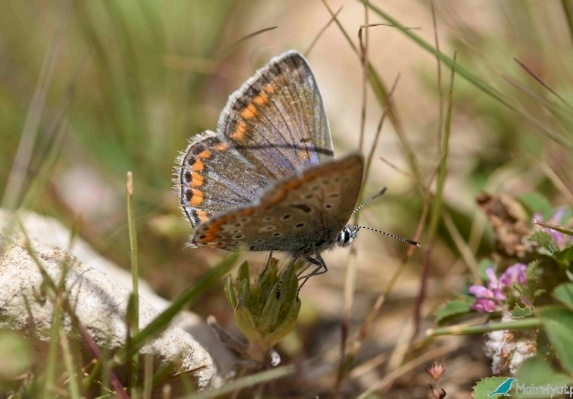Brown Argus
© All rights reserved by www.mahmiyat.ps
The Brown Argus is widely distributed throughout Europe, the Levant and Iran. It is a common species in central Palestine while some populations of this species in northern Palestine are connected with the Lebanese populations. In Jordan, it is a rare species.
Both males and females have a chocolate brown colour on the upper side of the fore and hindwings with a single series of orange coloured spots along the margin of the wings. There is also a white margin running on the outerside of these orange spots along the border of both sets of wings. A black spot is also seen in the centre of the upperside of the forewings. The underside of the wings are greyish brown in colour with white-bordered black spots and orange markings along the margin of the wings. These black spots on the underside of the wings also help in identifying this species separately from three other species of Blues - the female of the Common Blue, the Chalkhill Blue and the Adonis Blue.
The Brown Argus also does not have the two extra spots on the underside of the forewings, which are otherwise present in the Common Blue. The males and females of the Brown Argus look very similar except for the orange markings or spots which in the females are very distinctly prominent and extending upto the margin of the forewings while in the males they become very pale coloured or are completely absent at this part of the forewings. As they fly very low to the ground, very often their wings are observed to reflect a silvery appearance.
This species with a wing-span of 25-31 mm usually prefers dry grasslands but is also observed in sand dunes in the desert areas, open areas in woodlands, meadows and heathlands, border areas of crops fields and also sometimes in semi-urban areas like in the vegetation along roadsides. In the mountaineous regions, it is commonly seen in flowery grassy places. It has also been recorded in the grasslands along the coastal Mediterranean areas.
They normally have two generations in a year, one in the spring season and the second one towards the end of the summer time. This species is usually not seen to be flying in large groups with just one or two individuals seen at a time, although in closed vegetation areas they may be seen to be resting in colonies.
The adults lay eggs singly on the underside of the leaves. The larvae are green in colour with a reddish stripe along the side of the body. The foodplants are Erodium cicutarium and Helianthemum sp. The larvae have a close relationship with ants. The fully grown larvae hibernate all throughout the winter and the adults come out only during the spring.
Due to the similar upper wing colouration with that of the female of the Common Blue, it is often very difficult to identify it while in flight. However the only difference between the Brown Argus and the female of Common Blue is that the Brown Argus does not have any blue scales at the base of the wings.
The Brown Argus is also a close relative of the Northern Brown Argus, which however has no orange spots on the forewings and is found only in Scotland and northern England.
IUCN conservation status – Least concern
Picture Resource: By Andreas Eichler, CC BY-SA 4.0, Link


